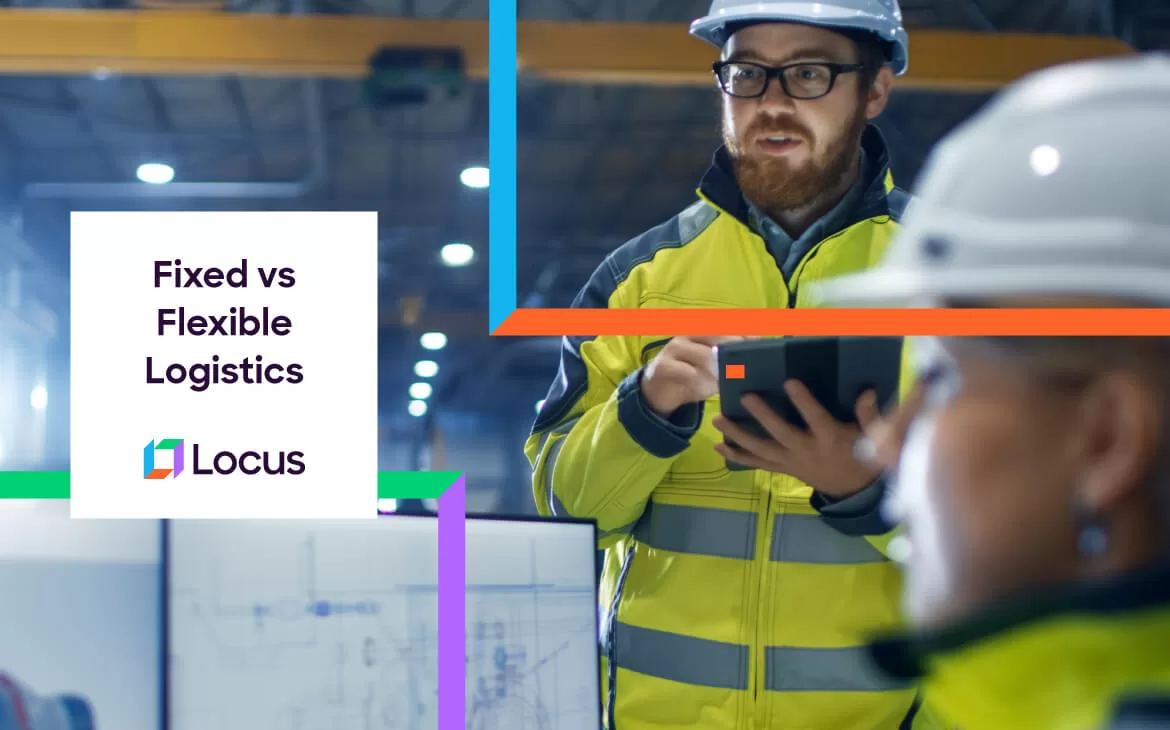Blog, Supply Chain Optimization
Fixed Logistics Model vs Flexible Logistics Model
Oct 5, 2021
10 mins read

Today, businesses are at the cusp of new changes in the supply chain that includes evolving customer expectations, omnichannel purchasing, and the shipping of unpredictable volumes. The unexpected disruption in the name of COVID-19 pandemic along with these changes has raised eyebrows.
With the supply chains of all businesses going through a transformational shift, it is important for them to make tough decisions concerning logistics models. Before the pandemic, fixed logistics had held a comparative advantage for gaining a larger customer base. After the pandemic hit, flexible logistics models helped businesses to easily penetrate into dense urban markets at economical costs.
Choosing the right logistics model determines the efficiency of its overall supply chain operations. However, a proper understanding is necessary of both fixed and flexible logistics models to make an appropriate decision.
What is fixed logistics?
A fixed logistics model is an asset-heavy model that businesses carry out for a fixed-term length in fixed locations. They establish this logistics model in owned or leased buildings. This model is best suited to manage complex logistics operations involving massive volumes of goods that require customization and automation.
What is flexible logistics?
A flexible logistics is an asset-light model that does not have term-length agreements, location constraints or area restrictions. This model makes it easier for businesses to quickly respond to supply chain disruptions and shifting market dynamics. It helps many brands support their omni channel logistics operations and enables retail businesses to set up e-commerce fulfillment networks.
How do businesses choose between fixed logistics and flexible logistics models?

New consumer expectations, along with the rising volumes from e-commerce channels has created a new imperative for businesses: either adapt or fall behind. In this phase of uncertainty and volatility, every brand has their task cut out to meet or exceed their consumer expectations, making the adoption of the right logistics models instrumental to fulfilling the expectations.
One of the most important strategic decisions for a supply chain is choosing between a fixed or flexible logistics model. Businesses prefer fixed or flexible logistics models based on different criteria and parameters.
Outsourcing to 3PL vs an in-house network
The decision to outsource logistics operations or owning a network depends on the customer demand. When businesses prefer to fulfill on-demand deliveries for products, then the most suitable move for them is to outsource their operations to a 3PL provider.
This is because 3PL providers have better resources in terms of manpower, technology etc. to handle on-demand deliveries consistently. If companies want to handle on-demand deliveries with their in-house resources, they might have to make large investments. To avoid these expenses, they work with a flexible logistics model for goods that require on-demand delivery.
Businesses that customize their operations for unique product characteristics prefer to work with an owned network. They deal with goods that have a significant volume of demand and operational complexity. They prefer fixed logistics when they deal with stable product lines.
Ex: Delivering items like books, clothes, electronic accessories, etc. comes with their unique challenges. Unlike food, medical items or grocery, these are products that enjoy significant demand on a seasonal basis. So, some businesses prefer greater control of their supply chains by working with a fixed logistics model. They deliver these products by pre-empting the seasonal demand and the operational complexity that comes with it
Differences in investment approaches
Fixed logistics incurs huge capital expenditure and operating expenses with predictable monthly costs over a fixed time period. They attract a high or atleast medium level of startup costs. By contrast, flexible logistics models do not involve any operating expenses for a fixed time period. It occurs only as a program-specific or project-specific investment. Its startup costs are low as compared to the fixed logistics model.
Scalability
The biggest difference between fixed and flexible logistics models is scalability. Businesses that want to expand their logistics operations regularly prefer to go with a flexible logistics model as it involves a lower cost to expand and takes less time to adjust to the demand changes. The ability to expand logistics operations in a flexible logistics model depends on the available capacity of goods and capabilities of businesses in certain markets.
A fixed logistics model is slow and incurs huge costs for expansion of logistics operations. The limitations of footprint and owned capabilities make it difficult for businesses to quickly and economically expand their logistics operations.
Time and speed of execution
The decision of businesses to prefer fixed or flexible logistics depends on the time and speed to implement it. Flexible logistics models are much better suited for businesses that want to improve their supply chain resilience. It takes around two to three weeks or a month for them to execute this model.
Businesses prefer a fixed logistics model when they don’t have immediate requirements to meet dynamic market demand. Not only is it expensive to implement and maintain, it takes anywhere between three months to a year to implement this model.
Predictable forecasts vs unpredictable forecasts
Fixed logistics is much suitable for businesses or portions of businesses that have stable and predictable sales. It suits high-volume logistics operations that are complex, and require automation to support unique business needs.
Flexible logistics model is much suited for businesses that develop faster and affordable delivery promises. It is beneficial for businesses in identifying future disruptions, managing fast-moving and unpredictable forecasts. Also, it is useful for those businesses that experience seasonal peaks and massive growth.
5 ways logistics and network optimization software benefit supply chains

Businesses prefer flexible or fixed logistics models based on different criteria and parameters as mentioned previously. But in the real world, many businesses follow a dynamic logistics model that blends the capabilities of both fixed logistics and flexible logistics models. This dynamic approach helps many businesses improve their logistics networks. It opens up new avenues for brands to provide flexibility in their expenses, location, and business. Also, this approach helps them improve their response time to supply chain disruptions.
The ultimate performance of a logistics model is tested at the last-mile, as optimizing delivery performance leads to a wider customer base. The primary tech tool that assists businesses to handle the last-mile is a logistics optimization software. It carves out new ways for them to maximize their on-time delivery rates and reduce their failed deliveries.
A well-planned delivery network is the foundation to the success of logistics operations, which is possible through supply chain network design. The most-preferred tool for designing supply chain networks is network optimization software. It is a key tech component that helps them build cost-effective supply chain networks.
Find out how logistics optimization and network optimization software benefits businesses that are willing to build optimal logistics models.
Positioning fulfillment centers and inventory
The last-mile segment attracts high costs for supply chain operations. Whether businesses want to expand their logistics networks or set up new logistics networks, it becomes crucial to carefully position inventory systems and fulfillment centers.
Network optimization software assists businesses to position their inventory systems closer to customers locations. With updated data on population in each delivery zone, they can effectively plan the inventory positions for dense and less densely populated areas. This helps them reduce the delivery times and minimize last-mile delivery costs.
Tracking ongoing deliveries
Regardless of whether a business chooses to work with a fixed or flexible logistics model, it becomes crucial to track the delivery status of shipments to carry out real-time troubleshooting, ensure delivery times are met, and improve the overall customer experience.
Logistics optimization software helps fleet managers regularly check the status of ongoing deliveries through crucial delivery metrics like idling time, transit time, dwell time, detention time, mileage, fuel consumption etc. With all this information, they can effectively work out the right contingency plans in case of vehicle downtime or rising delivery delays.
Develop multiple ‘what-if’ scenarios
Better supply chain decisions improve the profitability of a business and boost brand reputation. With thousands of products getting delivered on a daily basis through a supply chain network, it becomes essential to do proper scenario planning. Running through various ‘what-if’ scenarios enables businesses to gain much-required network flexibility and improves their resilience in times of supply chain disruptions.
The graphical illustrations of a number of scenarios from network optimization software helps businesses explore numerous options in optimizing their logistics. It helps them easily navigate all the ‘what-if scenarios’, analyze their result comparisons and finalize a supply chain decision.
Ex: Since the pandemic, all businesses are assessing if closing some of their distribution centers can minimize unnecessary costs.
With a network optimization software, businesses can study the trajectory of resources and cost expenditures over time as demand continues to increase or decrease. It assists businesses in identifying the implications of uncertainties and complexities in their network. Its scenario analysis helps them responsively adjust to changes occurring in consumer demand for products.
Improve delivery speed
In the age of same-day and next-day delivery, businesses should stay right on track by strictly fulfilling their delivery promises. Maintaining delivery speeds is necessary for them to boost their on-time delivery performance. In order to improve delivery speed, a proper investment into a tech tool is necessary and one such tool is the logistics optimization software.
Logistics optimization software helps businesses to build optimal route plans for their fleet drivers. Factoring numerous delivery constraints like traffic, delivery windows, etc. it generates a delivery schedule without burdening the resources and assets. Its optimal route recommendations help fleet drivers attain their delivery targets on-time, thereby elevating customer satisfaction.
Gaining more visibility across the supply chain
Improving supply chain visibility has been gaining attention from all businesses since the COVID-19 pandemic. It lays the much required foundation to improve efficiency right from the warehouse utilization to fleet utilization.
The right combination of logistics optimization and network optimization software improves the visibility of the supply chain. Whether it is maximizing warehouse space, minimizing inventory shrinkage, measuring transportation time or consolidating shipments, these tools can come in quite handy. They help businesses track and analyze different parts of the supply chain, improve their processes, and cut unnecessary costs.
Conclusion
Every business faces unexpected supply chain disruptions today owing to COVID-19. Pandemic-induced shocks in the supply chain have forced businesses to prioritize supply chain resilience. In these unforgiving times, businesses require a tech companionship to quickly respond to their supply chain disruptions.
Locus NodeIQ and delivery logistics software fits businesses working with either fixed logistics or flexible logistics models. The use of these tools benefits enterprises even if they follow a dynamic logistics approach. It helps them make the best use of systems, metrics, and processes to optimize their logistics performance.
Seeking a tech solution to counter supply chain disruptions? Try our services now!
Related Tags:

E-Commerce
The Top 6 Supply Chain Holiday Season Trends in 2021
US holiday retail sales in 2021 will rise 2.7% to $1.093 trillion, while the season’s ecommerce sales will rise 11.3% to $206.88 billion. Ecommerce will account for a record 18.9% of total holiday season retail sales. – US Holiday 2020 review and Holiday 2021 Preview, Emarketer Insider Intelligence, Feb 2021. With Covid-19 creating numerous disruptions, […]
Read more
Blog
Six Types of Warehouses You Should Know About to Strategize Demand Better
Customers are a moving target, and there is no single trick in the book to pin them down. The only way to ensure that a business continues flourishing is by keeping up with their ever-growing expectations. Intelligent warehousing is an underappreciated part of it. Despite the COVID-19 pandemic, there has been a steady increase in […]
Read moreMOST POPULAR
EDITOR’S PICKS
SUBSCRIBE TO OUR NEWSLETTER
Stay up to date with the latest marketing, sales, and service tips and news


Fixed Logistics Model vs Flexible Logistics Model